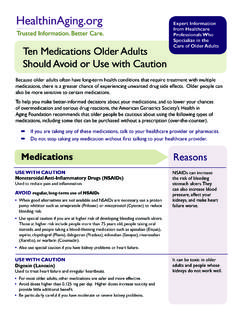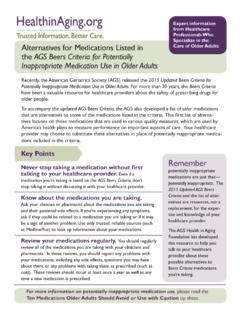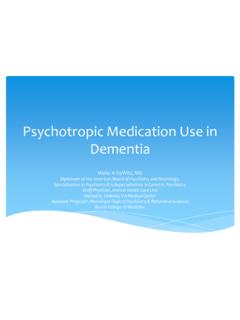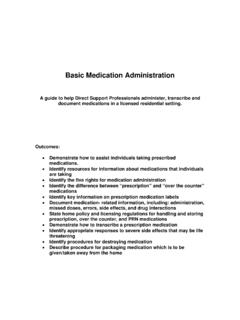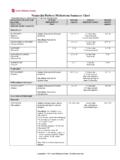Transcription of MEDICATIONS FOR CAMELIDS - icinfo.org
1 MEDICATIONS FOR CAMELIDS Pamela G. Walker, DVM, MS, DACVIM-LA Camelid Care Veterinary Services Findlay, OH 45840 The camelid population is continuing to grow in the United States with an increasing need for scientific information about proper dosage for MEDICATIONS in CAMELIDS . There is ongoing research in many institutions to try to find answers for these questions. The lack of complete information represents a challenge for veterinarians and camelid owners when determining a course of treatment for their camelid patients. As camelid owners it is important to work with your local veterinarian to plan treatment protocols for your llamas and alpacas. There are many factors to take into consideration when determining which drugs and what dosage to use in different situations. The information provided here is a basic guideline; specific treatments should be started only with the guidance of your veterinarian.
2 Due to lack of complete information, the dosages used in CAMELIDS are frequently taken from dosages used in cattle and horses. However, several differences have already been discovered, for example antibiotics, as a general rule, appear to have a longer time of action in CAMELIDS compared to domestic ruminants. There also seems to be a difference in dosing between llamas and alpacas. These differences can be dangerous and result in fatal over-dosages if the drug mechanism is not understood, for example Panacur and Valbazen doses. The choice of which drug to use in certain situations is a complicated decision and should not be decided upon in a cookie cutter manner. The age, sex, pregnancy status and general health of the alpaca/llama should be taken into consideration when deciding which drug to use. The following information is on drugs commonly used in alpacas and llamas. Abbreviations: PO orally, SC subcutaneous, IM intramuscular, IV intravenous SID once a day, BID twice a day, TID three times a day, QID four times a day EOD every other day, ETD every third day, IU international unit How to calculate how many mL (same as cc) to administer: Animal s weight: 100 lbs Drug concentration: 50 mg/mL Dose of drug: 2 mg/lb 100 lbs X 2 mg/lb = 200 mg of drug needed 200 mg 50 mg/mL = 4 mL of drug to administer Antibiotics A.
3 Sulfa drugs The ONLY use for Sulfa drugs in CAMELIDS is for the treatment of intestinal coccidia. The use of Sulfa drugs must be used with caution as a potentially fatal complication called Polioencephalomalacia can occur. Polioencephalomalacia is a condition where there is a sudden lack of Vitamin B1 in the first compartment and causes subsequent softening of the brain. This results in neurologic signs most notably blindness. Normally this condition can be treated by administering Thiamine (Vitamin B1), but when the condition is caused by Sulfa drugs, it is non-thiamine responsive and is usually fatal. 1. Albon (Sulfadimethoxine) comes in different concentrations and this will determine the amount to be given. See above calculation for example. Dose: Day 1: 25 mg/lb, PO, SID Day 2-5: 13 mg/lb, PO, SID 2. SMZ, TMS, TMP (Trimethoprim-sulfamethoxaole) is NOT effective orally in adults and ruminating crias (> 30-45 days), this has been proven conclusively by two scientific studies.
4 Dose: 8 mg/lb, PO, BID (Dose based on the Sulfamethoxaole portion) B. Penicillins In general considered to be a very safe class of drugs that can be used at very high dosages if needed. 1. Procaine Penicillin G (300,000 IU/mL) the only concentration available (do not use the Benzathine form). Commonly used to treat skin infections/wounds, infected foot pads, umbilical infections and follow up treatment for Listeriosis (bacterial infection in the brain). Best choice to use if Clostridium infection is suspected. Not a good choice for Upper Respiratory Infection or Pneumonia. Anaphylactic shock (respiratory failure and collapse) can occur on occasion and must be treated immediately with Epinephrine (1 mL/100 lbs, IM) to prevent death. If this happens, do not use this drug again in that animal. Dose: 10,000 IU/lb, SC, BID ( mL/ 25 lbs, mL/100 lbs) OR Dose: 20,000 IU/lb, SC, SID ( mL/25 lbs, 7 mL/100 lbs) 2.
5 Ampicillin comes as a SC form (Polyflex) and an IV form (Ampicillin sodium). Considered safe in other species, no studies done in CAMELIDS . Dose Polyflex: 10 mg/lb, SC, BID Dose Ampicillin sodium: 5 mg/lb, IV, TID to QID for Listeriosis 3. Naxcel, Excenel (Ceftiofur) commonly used to treat neonatal sepsis, upper respiratory infection, pneumonia, retained placenta and uterine infections. Naxcel can be used IV or SC. If used IV, must be given BID. With severe infections and SC usage, can also use BID. Excenel has the same parent drug as Naxcel, just a different carrier that allows it to be kept at room temperature, with a long expiration date; it should be given SC. Concentration for both is 50 mg/mL. Dose: 1 2 mg/lb, SC, IV, SID to BID ( mL/25 lbs, 2 4 mL/100 lbs) 4. Excede (Ceftiofur Crystalline Free Acid) a product labeled for respiratory infection in cattle and swine.
6 It is intended to be administered as a one time treatment SC at the base of the ear in cattle and IM at the base of the ear in swine. Due to this unique location of delivery of the drug, and the unique physiology of CAMELIDS , absorption may be unpredictable and no research has been done in CAMELIDS . Regardless of this, Excede has been used by many veterinarians in CAMELIDS with apparent success. When administered, it is important to confirm the needle is not in a vein (pull back on plunger to check for blood) as this drug will kill instantly if given IV. Excede is probably best reserved to use in animals that cannot be given injections every day. If needed, an additional dose can be repeated on day 4 if your veterinarian has determined it is appropriate. Dose: 3 mg/lb, SC, can repeated on Day 4 ( mL/100 lbs) C. Aminoglycosides Gentamicin, Amikacin should only be used with extreme caution as they can cause death due to kidney failure if given for prolonged periods (>5 days in a row) by IV, IM or SC route.
7 Kidney function should be monitored closely and the animals should only be given this drug class while supplemented with IV fluids. They can be used as part of an intrauterine lavage without risk of toxicity. Gentamicin and Amikacin Gentamicin is considered to be more kidney toxic than Amikacin in other species, regardless of which form is used , a maximum 5 day, once daily dosing is the recommended means of administration systemically. Dose: 2 3 mg/lb, SC, IV, SID, for 5 days ONLY D. Nuflor (Florfenicol) commonly used to treat upper respiratory infection, pneumonia, and tooth root infections in CAMELIDS . It is a broad spectrum antibiotic that is labeled to treat respiratory infections in cattle and is given every other day (EOD). Based on preliminary information from a study done at Oregon State University, in alpacas, the best dosing regimen in alpacas is daily dosing and the IM route. Due to how the drug is metabolized (by the liver), it should not be given to young crias (less than 3 months old).
8 Contraindicated to use with any other antibiotics. Can occasionally cause them to lose their appetite. Dose: 9 mg/lb, IM or SC SID (1 mL/35 lbs, 3 mL/100 lbs) E. Baytril 100 (Enrofloxacin) commonly used to treat neonatal sepsis, upper respiratory infection, pneumonia, and uterine infections in CAMELIDS . It is labeled for treatment of respiratory disease in beef cattle. It is considered to be a big gun and should not be used as a first choice antibiotic. In puppies (< 8 months), use of this drug is associated with cartilage damage in joints; it is unknown if the same is true for camelid crias. Use of this drug in cats has been associated with blindness with high doses and long term use; the same has been reported in a Guanaco after 26 days of therapy. Research has looked at oral absorption of this drug in CAMELIDS using double the injectable dose. There is absorption at mg/lb, PO, SID but it is still preferred to give Baytril either SC or IV.
9 It is considered to be a broad spectrum antibiotic, but does not work against Streptococci, Enterococci, Actinomyces, Pseudomonas bacteria or anaerobic infections. Dose: mg/lb, SC, IV, SID to BID (IV route) ( mL/25 lbs, mL/100 lbs) F. Biomycin 200, LA 200 (Oxytetracycline) used on the farm mainly for the treatment of Mycoplasma haemolamae ( Epe ) in CAMELIDS . It is a very irritating drug and should not be used IM. SC placement needs to be done carefully, alternating injection sites and thoroughly rubbing flat the drug under the skin. The brand Biomycin 200 is much less irritating and is the preferred product. It is labeled for every other day use in cattle, but the researcher at Oregon State University recommends it be given every three days (ETD) for 5 treatments. Noromycin 300 is also less irritating and can be used . In some cases of M. haemolamae it may take more than 5 treatments if the animal remains anemic. If it used IV, it must be given SID.
10 Dose: Biomycin 200 9 mg/lb, SC, ETD for 5 treatments ( mL/100 lbs) Noromycin 300 9 mg/lb, SC, ETD for 5 treatments ( mL/100 lbs) Anti-inflammatory, Analgesics (pain management) A. Banamine (Flunixin meglumine) this is a non-steroidal anti-inflammatory drug used to treat pain, inflammation and endotoxemia (toxins in the blood from bacterial infections). It does not have properties to directly cause calmness, except as what would be expected by the relief of pain. If used for long term, it may lead to ulcers in the third compartment. It should also be used with caution in dehydrated CAMELIDS as it can damage the kidneys. In dehydrated animals, use one-half dose until the animal is fully hydrated. Depending on the reason it is being used , once a day seems to be clinically adequate. If the animal becomes painful again after 12 hours, an additional dose can be given for short term use.
